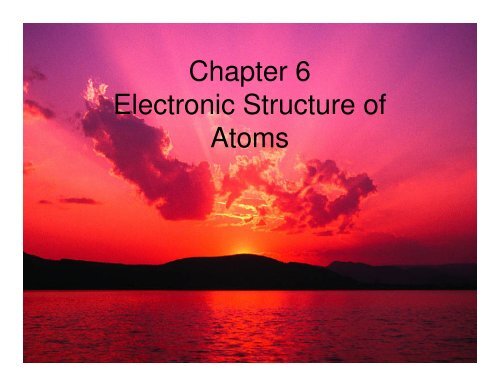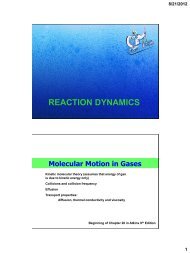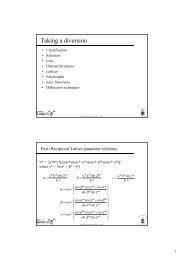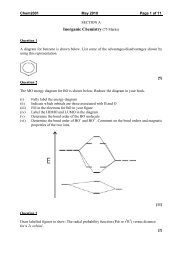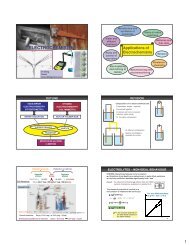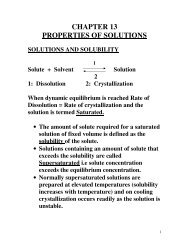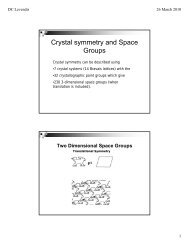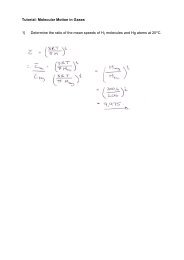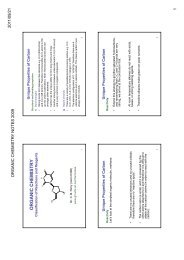n - Wits Structural Chemistry
n - Wits Structural Chemistry
n - Wits Structural Chemistry
- No tags were found...
You also want an ePaper? Increase the reach of your titles
YUMPU automatically turns print PDFs into web optimized ePapers that Google loves.
ExampleThe speed of a sound wave through a certain medium is320 m s -1 . What is the frequency if the sound has awavelength of 20.0 cm?v = λv320 m × 100 cm = 20.0 cm × νs m320 00 cm × 1 = νs 20.0 cm1600 s -1 = ν
For light and other electromagnetic radiation:2.998 x 10 8 ms -1c = λνExampleWhat is the wavelength of the radio waves from a transmitterbroadcasting at 105.5 MHz on the FM band?(c = 3.00 × 10 8 m/s)c = λv3.00 ×10 8 m × 1 s = λs 105.5 × 10 62.84 m = λ
All electromagnetic radiation (X-rays, UV, visible, infrared, radio waves, etc)• does not require a medium (propagation through a vacuum).• travels at the same speed, c.Electromagnetic Spectrumλλ
Red Orange Yellow Green Blue Indigo VioletVisible region of theelectromagneticspectrumwavelength (λ)frequency (ν)energy (E)
Classical Physics ~1800’sParticles.Radiation (Waves)Isaac Newton(1643-1727)James C. Maxwell(1831-1879)Classical physics cannot explain the following phenomena: Blackbody Radiation (emission of light from hot objects). Emission of electrons from metal surfaces on which light shines.(The Photoelectric effect) Emission of light from electronically excited gas-atoms.(Emission Spectra)
Blackbody RadiationIn physics , a black body is an objectthat absorbs all electromagneticradiation that falls onto it.In the 19th century physicists couldnot explain why the frequency oflight emitted by a black-body increasedwith an increase in temperature.They expected that the frequencyshould remain the same and theintensity should just increase.In practice objects become red-hot, andthen blue and finally white hot.Iron heated in a furnace formaking wrought iron.
Quantised Energy and PhotonsMax Planck and the study of radiation from hot bodies: energy canonly be absorbed or released from atoms in certain fixed amountscalled quanta, i.e. energy is quantised.E = hνJPlanck’s constant6.626 x 10 -34 JsEnergy of a quantum of light is relatedto its frequency (ν) and not intensity.Energy (and light) is quantised andhas particle-like properties!!!!!frequency(Hz, s -1) 1858 – 1947Physics Nobel prize [1918].
Common analogy to explain quantisation.Consider walking up a ramp versus walking up stairs.For the ramp, there is a continuous change in height whereas upstairs there is a quantised change in height.ExampleWhat is the energy of a photon of electromagnetic radiation thathas a frequency of 450 KHz?E = hvE = 6.63 × 10 -34 Js × 450 KHz × 1000 Hz × s -1KHz HzE = 2.98 × 10 -28 J
ExampleWhat is the smallest increment of energy (a quantum of energy)that can be absorbed or emitted at a wavelength of 450 nm?c = λv3.00 × 10 8 m = 450 × 10 -9 m × νs3.00 × 10 8 m × 1 = νE = hvE = 6.63 × 10 -34 Js × 6.67 × 10 14 s -1E = 4.42 × 10 -19 Js 450 × 10 -9 m6.67 × 10 14 s -1 = ν
The Photoelectric Effect and PhotonsFirst experimental evidence for quantisation: 1905 Albert Einstein usedPlanck’s quantum theory to explain the photoelectric effect.Metalsurfacehνelectromagneticradiatione -Positive terminal- +Each metal has a minimum frequency oflight below which no electrons are emitted.Albert Einstein 1879 -1955
If light shines on the surface of a metal electrons may beejected from the metal. This is the photoelectric effect. The electrons will only be ejected if the frequency of the lightis greater than a certain minimum frequency (the thresholdfrequency). Below the threshold frequency, no electrons areejected. Above the threshold frequency, the number of electronsejected increases as the intensity of the light increases. The kinetic energy of the emitted electrons increases as thefrequency of the light increases.
Einstein’s explanationEnergy is quantised; each quantum called a photonbeam of lightStream of energy packets (photons)Energy of each quantum given by the Planck equation:E = hνMinimum energy needed to release an e - from metal:work function, w o , of metal
Let w o = hυ oIf E < w o , i.e. if ν < υ o each photon does not haveenough energy to release e - ∴ no photoelectric effectIf E > w o , i.e. if ν > υ o each photon releases an e - , andE k of the e - is the energy of the photon that is greaterthan w ohυ = w o + E kE k = hν - w oKinetic energy ofphotoelectronEnergy ofphotonWork function ofmetal
ExampleTo release a photoelectron from Na requires a photon of energy4.41 x 10 -19 J. If Na is irradiated with light of 439 nm, what isthe maximum possible kinetic energy of the emittedphotoelectrons?E 439 = hcλE = hv= 6.626 × 10 -34 Js × 2.998 × 10 8 m439 × 10 -9 m s= 4.525 × 10 -19 Jc = λvE k = hν - w oE k = E 439 – 4.41 × 10 -19 JE k = 4.525 × 10 -19 J – 4.41 × 10 -19 J= 0.115 × 10 -19 J= 1.15 × 10 -20 J
Some properties of light can only be explainedusing a wave model (e.g., diffraction).Light has a dual nature: it has both wave andparticle propertiesDepending on experimental circumstances ,radiation has either wave-like or particle-like(photon) characteristics.
Line spectra and the Bohr model of the atomRadiation composed of only one wavelength is called monochromatic.Radiation that spans a whole array of different wavelengths is continuous.White light can be separated into a continuous spectrum of colours.NB:No blank or dark spotsoccur between the colours.V I B G Y O R
Line spectra and the Bohr model of the atom Different gases under reduced pressure emit differentcolored light by electrical discharge when high voltageis applied.The light has only a few wavelengths and represented bya colored line in the spectrum.ie., a line spectrum not a continuous spectrum isobtainedNa vapor – street lightsDark areas!!Dark areas between lines!!
Line spectra and the Bohr model of the atomRydberg discovered that the lines in the H-atomspectrum could be predicted by an empirical equation:Where λ is the wavelength of the line in the H-atomspectrum, R H is the Rydberg constant (1.096776 x 10 7 m -1 ),and n 1 and n 2 are positive integers such that n 2 > n 1 .1λ= ⎛ 1 1R ⎜−H 2⎝ n n21 2⎞⎟⎠
ExampleCalculate the wavelength in nm of the band in the spectrum of atomichydrogen that occurs with n 1 = 2 and n 2 = 3.1λ⎛ 1 1= R ⎜−H 2 2⎝ n n1 21/λ = 1.096776 x 10 7 m -1 x (1/(2 2 ) – 1/(3 2 ))= 1.096776 x 10 7 m -1 x (1/4 – 1/9)⎞⎟⎠410 434 486 656 nmλ = 1(1.096776 x 10 7 m -1 x (0.13889))= 6.56 x 10 -7 m= 6.56 x 10 -7 m x 1 nm10 -9 m= 656 nm
The Bohr Model of the Atom.In 1913 Neils Bohr offered an explanation for line spectra.According to classical physics, an electronmoving in a circular orbit as in the Rutherfordmodel should continuously radiate energy andspiral into the nucleus.Bohr got around this problem with threepostulates:Only orbits with definite radii are permitted.An electron in a specific orbit has an allowedenergy.Energy (hν) is emitted or absorbed only whenit changes from one state to another.Niels Bohr(1885-1962)Physics Nobel prize [1922]
Bohr calculated, using classical equations from the physics ofmotion and interacting charges, the energy of each orbit of theelectron in the hydrogen atom.E= ( −hcRH1)2n= ( −2.18×10−181J )2nThe energies of transitions in the H-atom are given by:∆E = hν = hc/λ = (-2.18 × 10 -18 J)(1/n f2 – 1/n i2 )n i is the principal quantum number of the initial state.n f is the principal quantum number of the final state.Transitions can occur when n f is greater than n i , i.e. energy isabsorbed, or where n f is less than n i , when light is emitted.∆E = 1/λ = - R H (1/n f2 – 1/n i2 )1/λ = R H (1/n i2 – 1/n f2 ) Rydberg Equation
The Bohr Model of the Hydrogen Atom.GroundstateExcitedstatesn = 1n = 2n = 3n = 4n = 5n = 6electrons confined toorbits of specific radiicalled stationary statesIn a stationarystate, e - cancircle nucleuswithout losingenergy.nucleusNote: n is called the Principal Quantum Number
- 1 / 16hcR H0- 1 / 9hcR H-¼hcR Hn = ∞n = 4n = 3n = 2Energy = 0Energy isnegative- hcR Hn = 1The furthest orbit in the Bohr model has n close to infinity andcorresponds to zero energy, i.e., the electron has escapedfrom the influence of the nucleus. (Reference point)The first orbit in the Bohr model has n = 1; it is closest to thenucleus, and has negative energy by convention.
0- 1 / 16hcR H- 1 / 9hcR H-¼hcR H- hcR Hn = ∞n = 4n = 3n = 2n = 1ExcitedstateshvGround stateemission of aphoton aselectronreturns toground stateElectrons in the Bohr model can only move between orbits byabsorbing and emitting energy in quanta (hν).
0- 1 / 16hcR H- 1 / 9hcR Hn = ∞n = 4n = 3Excitedstates-¼hcR H- hcR Hhvn = 2n = 1absorption ofa photon aselectron isexcited tohigher energystateGround stateElectrons in the Bohr model can only move between orbits byabsorbing and emitting energy in quanta (hν).
- 1 / 16hcR H0- 1 / 9hcR H-¼hcR Hn = ∞n = 4n = 3n = 2- hcR Hn = 1Electrons in the Bohr model can only move between orbits byabsorbing and emitting energy in quanta (hν).The amount of energy absorbed or emitted on movementbetween states is given by∆E = E - E = hνfinalinitial
- 1 / 16hcR H0- 1 / 9hcR H-¼hcR Hn = ∞n = 4n = 3n = 2∆E = E - E = hνfinalinitial- hcR Hn = 1∆E will be quantised and hence will get line spectra
Paschenn 6→2n 5→2n 4→2n 3→2BalmerTransitions of the Balmer SeriesObserved in the visible region of the electromagneticspectrum.LymanJohann Balmer(1825-1898)SchoolTeacher
(i)ExampleWhich quantum numbers are involvedin the transition that requires the mostenergy?n = 1 and n = 4(ii) And the least energy?(iii) How many lines would be observed inthe emission spectrum of this system?(iv) And in its absorption spectrum?
(i)ExampleWhich quantum numbers are involvedin the transition that requires the mostenergy?n = 1 and n = 4(ii) And the least energy?n = 1 and n = 2(iii) How many lines would be observed inthe emission spectrum of this system?(iv) And in its absorption spectrum?
(i)ExampleWhich quantum numbers are involvedin the transition that requires the mostenergy?n = 1 and n = 4(ii) And the least energy?n = 1 and n = 2(iii) How many lines would be observed inthe emission spectrum of this system?6(iv) And in its absorption spectrum?
Example(i)Which quantum numbers are involvedin the transition that requires the mostenergy?n = 1 and n = 4(ii) And the least energy?n = 1 and n = 2(iii) How many lines would be observed inthe emission spectrum of this system?6(iv) And in its absorption spectrum?6
ExampleWhat is the wavelength of the energy that must be absorbedfor an electron to be promoted from the n=1 to the n=3 level ina H atom?1/λ = 1.096776 x 10 7 m -1 x (1/(1 2 ) – 1/(3 2 ))= 1.096776 x 10 7 m -1 x (1 – 1/9)λ = 1(1.096776 x 10 7 m -1 x (0.8889))= 1.025 x 10 -7 m= 1.025 x 10 -7 m x 1 nm= 103 nm10 -9 m1λ= ⎛ 1 1R ⎜−H 2⎝ n n21 2⎞⎟⎠Lyman Series not in the visible region of the spectrum
Limitations of the Bohr Model of the Atom.It cannot explain line spectra of atoms other than that ofhydrogen very accurately. i.e., many electron atoms.Describes electron as a particle circling the nucleus nottaking into account the wave-nature of the electron.Significant points:Electrons are in discrete energy levels within the atom.Energy (hν) is involved in moving from one level to another.
The Wave Behaviour of Matterde Broglie’s proposed that matter also has waveproperties.For a particle of mass (m) moving with velocity (v) :Wavelength (nm)• Louis de Broglie(1892 - 1987)λ =hmvmomentumPlanck’s constantVelocity (m/s)Mass (kg)The electron thus is not only a particle, but also a wave.Confirmed by the fact that electrons can be diffracted by crystals.Since electrons are waves, it is inappropriate to treat them only asparticles, as in the Bohr model of the atom.
ExampleWhat is the wavelength of an electron (m = 9.11 x 10 -31 kg)traveling with a speed of 0.01 c (1% speed of light)?NB: J = kgm 2 s -2= 6.626 × 10 -34 Jsλ = hmv9.11 × 10 -31 kg × 0.01 × 2.998 × 10 8 ms -1= 2.212 × 10 -10 m= 0.221 × 10 -9 nm (Wavelength compares to that of X-rays)Compare to wavelength of a ball (m = 100 g; v = 30 m s -1 )?λ = hmv= 6.626 × 10 -34 Js100 × 10 -3 kg × 30 ms -1= 2.209 × 10 -34 m(Wavelength is extremely small)The wavelength property of matter is only important forvery small particles traveling at very high speed.
Heisenberg Uncertainty PrincipleBecause of wave nature of matter,cannot determine precisely themomentum or the position of a smallparticle moving at high speed.If ∆x is the uncertainty in positionand ∆mv is the uncertainty inmomentum, then( ∆x)· ( ∆mv)≥4hπ•Werner Heisenberg(1901-1976)Physics Nobel prize [1933]
Illustration of the Uncertainty PrincipleAn electron moves at a speed of approximately 5 ×10 6 m/s in thehydrogen atom. If we know the speed to an uncertainty of 1%,calculate the uncertainty in the position of the electron.∆v = 0.01 × 5 × 10 6 m/s = 5 × 10 4 m/s∆x = h4πm∆v= 6.626 × 10 -34 Js4 × π × 9.11 × 10 -31 kg × 5× 10 4 ms -1= 1 × 10 -9 mThe diameter of the hydrogen atom is of the order of 1 × 10 -10 m.Our uncertainty is an order of magnitude greater than the size ofthe atom. We do not know where the electron is located!!!
Quantum Mechanics and Atomic OrbitalsIn 1926 Erwin Schrödingerproposed the wave equationwhich led to quantum mechanics.Schrödinger’s quantummechanical description of atomicstructure:H Ψ = EΨHΨ = EΨHamiltonianoperator –describeselectron’s E kand E pAllowed energylevels of an electronin an atom(quantised)Erwin Schrödinger (1887-1961)Electron in an atom described by a wave function, ψ.ψ has no physical meaning; but ψ 2 ∝ probability of finding anelectron in a region of space.probability density
Atomic OrbitalsBohr’s modelelectron circles around nucleusOrbitPrincipal quantum numbern = 1Schrödinger’s modelelectron is within a region -Statistical knowledge of theelectron’s location.Principal quantum numbern = 1Orbitalprobability or electron densityThe solution to the Schrödinger wave-equation leads to a set ofwavefunctions that yields 4 types of quantum numbers instead of thesingle quantum number yielded by the Bohr model.
Quantum Mechanics and Atomic OrbitalsAllowed energy levels: orbitalsDescribed by three quantum numbers:n – principal quantum number (shells)Gives the energy level of the electron in the atomn = 1, 2, 3, 4, …, ∞l – azimuthal quantum number (subshells)Gives the shape of the orbitall = 0, 1, 2, 3,…, (n-1)s p d fm l – magnetic quantum numberGives the directional properties of the orbitalm l = -l, (-l+1), (-l+2), … , (l-2), (l-1), li.e., orientation in space of 2l+1 orbitals
Examplen = 3 (3 rd energy level of atom or 3 rd electron shell)∴ l = 0, 1, 23 subshellsm l = 0one sorbitalm l = -1, 0, 1three porbitalsm l = -2, -1, 0, 1, 2five dorbitals
ExampleGive the values of n, l, and m l for each orbital in the(i)(ii)2p subshell5d subshellAnswer:(i) 2p subshelln = 2, l = 1, m l = -1, 0, 1(ii) 5d subshelln = 5 , l = 2, m l = -2 ,-1, 0, 1, 2
n = 3 (3 rd energy level of atom)∴ l = 0, 1, 2m l = 0one sorbitalm l = -1, 0, 1three porbitalsm l = -2, -1, 0, 1, 2five dorbitals
All s-orbitals are sphericalAs n increases, the s-orbitals get larger
Electron probability plotContour plot encompassing forexample >90% probability of finding anelectron in that region of space
0.529ÅElectron density× 4πr 2Distance from nucleus
Contour plot
0.5Å3Å× 4πr 2
A node is a region in space where theprobability of finding an electron is zeronodeAt a node, Ψ 2 = 0
As n increases, the number of nodes increases.For an s-orbital, the number ofnodes is given by (n - 1).
p. 236
n = 3 (3 rd energy level of atom)∴ l = 0, 1, 2m l = 0one sorbitalm l = -1, 0, 1three porbitalsm l = -2, -1, 0, 1, 2five dorbitals
p. 237•There are three p-orbitals p x , p y , and p z .•The three p-orbitals lie along the x-, y- and z- axes of aCartesian system.•The letters correspond to allowed values of m l of -1,0, and +1
Contour plots.m l = -1m l = 1 m l = 0p. 237•The orbitals are dumbbell shaped.•As n increases, the p-orbitals get larger.•All p-orbitals have a node at the nucleus(and other nodes for n ≥ 3)
n = 3 (3 rd energy level of atom)∴ l = 0, 1, 2m l = 0one sorbitalm l = -1, 0, 1three porbitalsm l = -2, -1, 0, 1, 2five dorbitals
d - orbitals
f - orbitals
In the H atom, allorbitals in a shellhave the sameenergyThis is called anAUFBAU diagram.Describes theenergy order oforbitals in theshells.
s orbitals have Ψ 2 ≠ 0 at the nucleus.Therefore electrons in s orbitals feel fully the effect of thenuclear charge.
s orbitals have Ψ 2 ≠ 0 at the nucleus.Therefore electrons in s orbitals feel fully the effect of thenuclear charge.In the case of p, d and f orbitals, there is a node at thenucleus.Electrons in these orbitals feel the nuclear charge less.
s orbitals have Ψ 2 ≠ 0 at the nucleus.Therefore electrons in s orbitals feel fully the effect of thenuclear charge.In the case of p, d and f orbitals, there is a node at thenucleus.Electrons in these orbitals feel the nuclear charge less.In fact, they are screened from the nucleus by the s electrons,and by electrons in inner shells.
Effectivenuclear chargeActual nuclearchargeScreening effect of innerelectronsAs the effective nuclear charge on an electron decreases, theelectron moves further from the nucleus and its energyincreases (less coulombic attraction by nucleus).Hence for a given shell the energy of the orbitals becomes:s < p < d < f …
This energy level diagram isfor one electron atoms only:H, He + , Li 2+ , etc…
For multi-electronatoms (He, Li, Li + ,etc.) the orbitalenergy leveldiagram isdifferent:and shellsbegin tooverlapEnergy of theorbitals increasewith an increasingvalue of lHow do we place electrons in the orbitals?What is the electron configuration …?
Stern-Gerlach Experiment:1921 Otto Stern & Walter GerlachElectrons have an additional propertydependent on their magnetic field.Beam of atoms with anodd number of electronsfocusing slitmagnetic fielddetectorElectrons interact with magnetic field producing two equivalent beams.
Electrons have a property called spin.Represented in chem as ↑ and↓Spin is a quantised property governed by a spin quantumnumber S. The possible values are called m sm s = +½ or –½
Pauli’s Exclusion PrincipleNo two electrons in an atom can have the same set of 4quantum numbers. i.e., electrons in an orbital must haveopposite spins.Effect of this: only 2 electrons can occupy any one orbitaln = 3l = 1m l = 1m s = +½↑↓3p xn = 3l = 1m l = 1m s = -½The Exclusion Principle governs the way that electronscan be accommodated in the orbitals of an atom.
Examples:Orbital diagramm s= ½m s= -½Have the same energy1s subshell fullFirst shell full2 electrons1s 2 2s 2 2p 12s subshell full2 electronsElectron configuration
Examples:m s= ½Parallel spinsHave the same energyHund’s Rule:For degenerate orbitals thelowest energy configurationhas the highest number ofunpaired electrons.Orbital diagram1s 2 2s 2 2p 2Electron configuration
Examples:m s= ½Have the same energyOrbital diagram1s 2 2s 2 2p 3Electron configuration2p subshell ishalf full3 electrons
Examples:Electron pairOrbital diagram1s 2 2s 2 2p 4Electron configuration
Examples:Orbital diagram1s 2 2s 2 2p 5Electron configuration
Examples:2p subshell is full6 electrons accommodatedOrbital diagram1s subshell fullFirst shell full2 electrons1s 2 2s 2 2p 62s and 2p subshells fullSecond shell is full8 electronsElectron configuration
The periodic table reflects the electron configuration of theelements. The best guide for order in which orbitals are filledH1s 1s 2He1s 2 2s 2S: 1s 2 2s 2 2p 6 3s 2 3p 4Li Be B C N O F NeNa Mg Mg: 1s 2 2s 2 2p 6 3s 2S
Condensed Electron ConfigurationsMg: 1s 2 2s 2 2p 6 3s 2is written for convenience asMg:[Ne]3s 2Valence Electrons. i.e., outer-shell electronsCore Electronsmeaning: the same electron configuration as a neutral Ne atomS: 1s 2 2s 2 2p 6 3s 2 3p 4S:[Ne] 3s 2 3p 4Valence Electrons. i.e., outer-shell electronsCore Electronsmeaning: the same electron configuration as a neutral Ne atom
2e -Transition metals.(d – orbitlas are filled)3d subshell half full5 electrons accommodated2e - 6e -d 1 d 102e - d 56e -2e -ScMnZn
Transition metalsSc: 1s 2 2s 2 2p 6 3s 23p 6 4s 2 3d 1Ti: 1s 2 2s 2 2p 6 3s 23p 6 4s 2 3d 2V: 1s 2 2s 2 2p 6 3s 23p 6 4s 2 3d 3↿⇂↿⇂↿⇂⇂ ↿ ↿⇂↿⇂⇂⇂⇂⇂↿↿↿↿2e - 6e - 10e -2e -Mn: 1s 2 2s 2 2p 6 3s 23p 6 4s 2 3d 5Fe: 1s 2 2s 2 2p 6 3s 23p 6 4s 2 3d 6↿⇂↿⇂↿↿↿ ⇂⇂⇂2e - 6e -Zn: 1s 2 2s 2 2p 6 3s 23p 6 4s 2 3d 10 Sc: [Ar] 4s 2 3d 1Zn: [Ar] 4s 2 3d 102e -
Anomalous Transition Metals.Copper (Cu) and Chromium (Cr)↿↿⇂↿⇂↿⇂↿⇂↿⇂↿↿↿↿↿↿↿⇂↿⇂↿⇂↿⇂↿⇂↿⇂↿⇂↿⇂↿⇂↿⇂↿⇂↿⇂↿⇂↿⇂↿⇂↿⇂↿⇂↿⇂Cu: 1s 2 2s 2 2p 6 3s 2 3p 6 4s 3d 10 Cr: 1s 2 2s 2 2p 6 3s 2 3p 6 4s 3d 5Cu: [Ar] 4s 3d 10Cr: [Ar] 4s 3d 5
Ga: [Ar] 4s 2 3d 10 4p 1Ga
Pb: [Xe] 6s 2 4f 14 5d 10 6p 2Pb
Electronic Structure of IonsAtoms gain or lose electrons to obtain the closest Noble gas configuration.Ne electron configurationAr electron configurationMetal atoms tend to lose electrons to become cations;non-metal atoms tend to gain electrons to form anions.How do the electron configurations of ions differ fromthat of their parent atoms?
Electronic Structure of IonsCation - remove electron/s from the valence orbitals withthe highest principal quantum number.i.e., the occupied orbital with the largest principalquantum number (n)Anion - add electron/s to empty or partially occupiedvalence orbitals with the lowest principal quantumnumber.i.e., the partially occupied or unoccupied orbital with thelowest principal quantum number (n)
ExampleWhat is the electron configurationfor sodium and that of its ion?Show this by means of an orbitalenergy diagram giving also thecondensed electron configuration.Periodic table: 11 Na – 11 e -Na: 1s 2 2s 2 2p 6 3sNa: [Ne] 3s11Na is a metal therefore forms a cationby loosing the highest energy electron.(Valence electron)i.e., the occupied orbital with the largestprincipal quantum number (n)↿↿⇂↿⇂2e - 6e -Valence electron↿↿↿ ⇂⇂⇂2e - 6e -2e -Na + : 1s 2 2s 2 2p 6Na + : [Ne]Na + and Ne are isoelectronic
ExampleWhat is the electron configurationfor chlorine and that of its ion?Show this by means of an orbitalenergy diagram giving also thecondensed electron configuration.Periodic table: 17 Cl – 17 e -Cl: 1s 2 2s 2 2p 6 3s 2 3p 5Cl: [Ne] 3s 2 3p 517Cl is a nonmetal therefore forms ananion by gaining an electron into anunoccupied or partially occupied orbital.i.e., the partially occupied or unoccupiedorbital with the lowest principal quantumnumber (n)↿⇂↿⇂↿⇂↿⇂↿⇂↿⇂2e - 6e -↿↿↿ ⇂⇂⇂2e - 6e -2e -Cl - : 1s 2 2s 2 2p 6 3s 2 3p 6Cl - : [Ar]Cl - and Ar are isoelectronic
Isoelectronic IonsIons – that contain the same number of electrons.ExampleWhat is the electron configuration for the ions of calcium and sulfur?↿⇂↿⇂↿⇂↿⇂↿⇂↿⇂↿⇂↿⇂↿⇂↿⇂↿⇂↿⇂↿⇂↿⇂↿⇂↿⇂↿⇂Ca 2+ : [Ar]↿⇂↿⇂ Valence electronS: [Ne] 3s 2 3p 4Ca 2+ , S 2- and ArIsoelectronic↿⇂S 2- : [Ar]Ca: [Ar] 4s 2
Transition Metal Ions1 st and 2 nd row transition metal – ions formed by removing4s electrons before removing d–electrons !!!Recall:Cation - remove electron/s from the valence orbitals withthe highest principal quantum number.Examplea) What is the electron configuration for the ion Sc 3+ ? Show the orbitalenergy diagram and the condensed electron configuration.b) What is the electron configuration for Fe and the ferric and ferrousions? Show the orbital energy diagram and the condensedelectron configuration.
Answer (a)Sc: 1s 2 2s 2 2p 6 3s 23p 6 4s 2 3d 1↿⇂Sc: [Ar] 4s 2 3d 1Sc 3+ requires 3e - belost by the scandium ↿⇂atom. 4s 2 3d 1Sc 3+ : [Ar]↿⇂↿⇂⇂ ↿ ↿⇂↿↿↿ ⇂⇂⇂↿↿⇂
Answer (b)Fe: 1s 2 2s 2 2p 6 3s 23p 6 4s 2 3d 6Fe: [Ar] 4s 2 3d 6Fe 2+ (ferrous) requires2e - be lost by the ironatom.4s 2↿⇂⇂↿⇂↿⇂⇂ ↿ ↿⇂↿↿↿↿↿⇂Fe 2+ : [Ar] 3d 6↿↿↿ ⇂⇂⇂↿⇂↿⇂
Answer (b)Fe: 1s 2 2s 2 2p 6 3s 23p 6 4s 2 3d 6Fe: [Ar] 4s 2 3d 6Fe 2+ (ferrous) requires2e - be lost by the ironatom.4s 2↿⇂⇂↿⇂↿⇂⇂ ↿ ↿⇂↿↿↿↿↿ ⇂Fe 2+ : [Ar] 3d 6↿↿↿ ⇂⇂⇂Fe 3+ (ferric) requires 3e -be lost by the iron atom.↿⇂4s 2 3dFe 3+ : [Ar] 3d 5↿⇂
Anomalous Transition Metals.(Cu 2+ ) and (Cr 3+ )↿↿⇂↿⇂↿⇂↿⇂↿⇂↿⇂↿⇂↿⇂↿⇂↿↿⇂↿↿↿↿↿↿⇂↿⇂↿⇂↿⇂↿⇂↿⇂↿⇂↿⇂↿⇂↿⇂↿⇂↿⇂Cu: [Ar] 4s 3d 10Cu 2+ : [Ar]3d 9↿⇂Cr: [Ar]4s 3d 5Cr 3+ : [Ar]3d 3
End of Chapter 6:Electronic Structure of Atoms
ExampleThe diagram shows the wavefunction of a hypothetical one-dimensionalsystem where Ψ is defined between x and 2π as Ψ(x) = sin x.(i) Sketch the probability density function Ψ 2 (x).(ii) At which value(s) of x will Ψ 2 (x) be a maximum?(iii) And a minimum?


